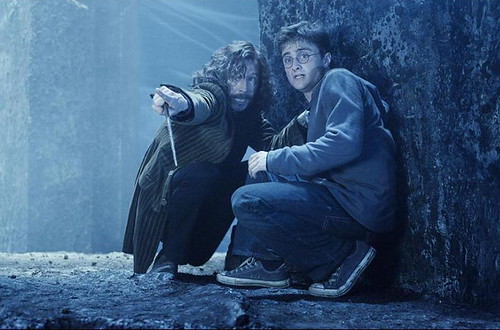Given the rather mixed & muted reviews it’s received, I was surprised to discover that Harry Potter and the Order of the Phoenix (HP5) is the best motion picture in this series to date. It achieves this, one of my sons avers, by cutting back everything that doesn’t contribute to its primary narrative drive – the battle between Harry & Voldemort to see into and control one another’s mind. It’s an epic battle from the very first scene to the last. It may well be that there’s much more going on in the books than in the films – I’ve found the novels mostly unreadable, but I’m hardly the target audience – but as films the series has been, at best, uneven, going through four directors: Chris Columbus (numbers one & two), Mike Newell (HP3) & Y tu mamá también director Afonso Cuarón (HP4), before turning to veteran TV director David Yates for this film & the next. Steve Kloves, who wrote the script for the first four films took a break on this one in order to work on a separate project, a script for The Curious Incident of the Dog in the Night Time, but has already signed on to write the next two. So HP5 will turn out to be the one film in the sequence written by Michael Goldenberg, who also penned the screenplays for Contact & Peter Pan. I remember after the completion of the second film that Columbus swore that the personal toll of doing two such complicated films back to back was beyond his capacity as a human, & I take him at his word. But this kind of shuffling of directors has a lot to do with the limits of these films, since the one controlling vision that remains constant throughout is that of J.K. Rowling, who is at two removes from the final product.
The other constant, of course, are the actors, particularly the kids – we are, after all, into our second Dumbledore. To a degree that has not been the case in any of the previous films, the younger thespians are a strength of HP5. Emma Watson remains the best of the three lead actors, tho her role in this film is more abbreviated than in any of the four previous ones¹, but Rupert Grint – a lock to play James Bond in another 25 years – and Daniel Radcliffe have likewise gone from being kids in a film to serious actors, as have several of the secondary child actors, most notably Matthew Lewis’ as Neville Longbottom, a key figure here, and James & Oliver Phelps as the Weasley twins.
One of the more interesting subtexts of this series has been watching these youngsters emerge as adults, still a work-in-progress. Radcliffe has gone from being a fresh-faced boy with a pretty typical, almost generic face into an adult with an interesting & somewhat unusual look. He’s visibly shorter than most of his peers, Lewis & the twins in particular, & almost certainly doesn’t look like what a casting director might have picked to play Harry Potter now. But the role is so completely his that it’s no problem & his divergence from “
This is the intersection between film & time, something that has fascinated both photographers & their critics almost since the dawn of daguerreotypes. We see a star, say, Judy Garland frozen at a particular moment in her adolescence in The Wizard of Oz, even knowing full well what a sodden mess she later made of her adult life, but in this scene, this film, she is for all purposes perfect. The intersection works other ways as well. Think of how many times in recent years you’ve seen some old film with a pre-Lord of the Rings Viggo Mortensen in it, playing some sleazy young thug. You may have seen the film, or parts of it, a half dozen times on the telly, never before paying attention to this secondary role whose actor seems to have been selected for his ability to convey sliminess. Or the next time you see To Kill a Mockingbird, note Robert Duvall as Boo Radley, or catch Harrison Ford as a young officer in the opening scenes of Apocalypse Now, or both Ford and Duvall in minor spots, Duvall technically uncredited even, in Francis Ford Coppola’s great detective drama, The Conversation.
It doesn’t need to be film, or cinema, to create these effects. Any photograph of Abraham Lincoln, for example, carries this effect, or any still of JFK & Jackie in the convertible in
HP5, as the critics have all noted, is a much darker film. Potter is, as he says, “angry all the time.” Ron Weasley has his own surly moments, as does Nigel Longbottom. It’s the dark night of the teen years, only in this fable the dysfunctionality of the family (fabulously figured by Sirius Black’s literal family tree, many of its faces burned or blackened by scandal & conflict, the worst yet to come) is weighted with the whole axis of good & evil. In the portraits that invariably decorate the walls of this film, old Hogwarts faculty, dead ancestors, even kittens move & blink & meow. So also in the aging of its cast, this curious & flawed film franchise manages to figure its most powerful message, that of time.
¹ Steve Kloves has described Hermione as the character he most enjoys “writing for,” suggesting that Watson will play larger roles again in the final two films.






